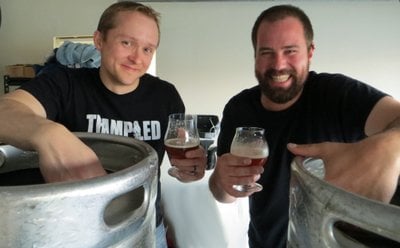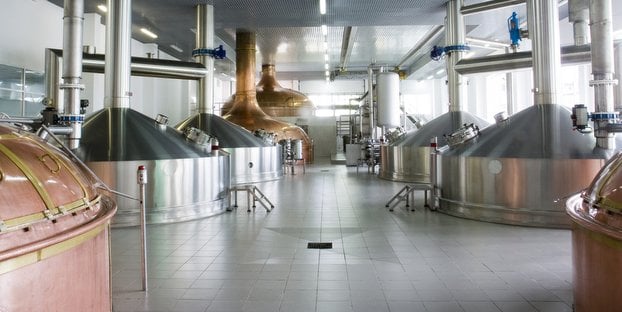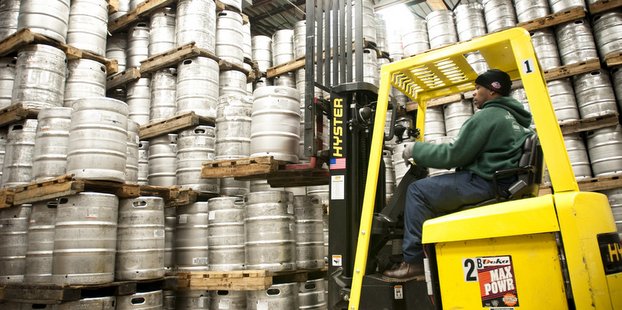How do you turn a brewing passion into a brewing business? Craft brewers across the country mull that question over each day, with each brewer needing to address regional challenges and seek new strategies for seizing opportunities. What sets you apart? Will your production/revenue equation justify your company’s existence?
Take Spencer O’Bryan and Brennan Mann, for example. The two had homebrewed and studied brewing as a hobby for much of the last decade, but then became interested in bringing this beer passion to a wider audience in their local area. Their local area also happens to be Denver, one of the more competitive areas for craft brewing in the country. Launching a new craft brewing brand here would require some serious strategic planning, which led them to the fall 2012 NxLeveL for Start-Ups course at the Denver Metro Small Business Development Center (SBDC), which was a crash course in business plan writing.
“Right from the beginning, we knew we would need help in writing the business plan,” O’Bryan told Craft Brewing Business. “Not because we were incapable of piecing together the details or even formatting the plan properly, instead our goal was to use the classes to form a well thought-out plan in the quickest manner possible. We hoped that the classes would give us a good foundation for writing the business plan as well as expose details in the plan writing process that we otherwise would have overlooked. In addition, we used the class as a catalyst to get the business plan completed.”

In working through the business details in the class in order to construct the business plan, O’Bryan and Mann understood the goals and focus of their brewing venture on a whole different level.
“It forced us to consider what we really wanted to accomplish by opening a brewery,” O’Bryan said. “We learned that at our core we are about quality, community and transparency.”
“The plan also helped us as a team,” Mann said. “More often than not, we brought ideas to the table individually and came away with more comprehensive, better-formed ideas in the end.”
After the class, the business plans were submitted into a competition, and the team’s plan finished second out of 29 entries in the Denver Metro Regional Business Plan Competition. From there, the business plan was submitted to the 2012 Leading Edge Statewide Business Plan Competition. Their plan finished second again, this time out of the statewide pool consisting of 35 business plans.
According to the judges, the plan was ranked second because of the amount of detail included in the plan. It showed a clear understanding of the elements that needed to be addressed, including their executive summary, product description, market and marketing strategy, management and operations. Their assumptions were realistic and reasonable. The financial piece was presented in good form and followed generally accepted accounting principles that were consistent with the rest of the plan. Overall, the plan was clear and concise.
“The plan serves two purposes at this point,” O’Bryan said. “The first being to help define our business moving forward and provide a reference for operations. We realize that plans have to be a living thing, as constant change and adaptation are critical to success. Secondly, the plan helps relay the base plan for the business and operations to investors and lenders.”
The plan behind the plan
Our concern is making great beer that we love, not making a buck. But in reality, unless you have an extremely detailed way to track and predict finances, you won’t be able to make great beer for very long. — Spencer O’BryanAs the judges noted, the business plan stood out because of the detail, details that also helped better form the conception of the brewery, specifically with the marketing and financing pieces.
The marketing portion of the plan, for example, focused not only on how the team plans to bring its new beers to the market and become established as a part of the community, it also gave detailed statistics on which neighborhoods would be ready for a craft brewery. The financial portion went to a similar level of detail. It included detailed cash flow projections, even down to the projected sales of individual beer styles based on current market trends.
“It also forced us to consider cycle time for fermenters and brewhouse time,” O’Bryan said. “This is most definitely a portion of the plan that will change the moment we start to brew and sell beer, but it gives us a great baseline from which to work. Our concern is making great beer that we love, not making a buck. But in reality, unless you have an extremely detailed way to track and predict finances, you won’t be able to make great beer for very long.”
Other details that the two mapped out in the plan included the look and feel of the taproom, examples of labels and tap handles and exactly what they’d plan to do to fulfill the “community involvement” aspect of their company creed.
“We had so many great ideas during our plan writing process, the plan became a way to catalog everything,” Mann said.
Brewers, brewers everywhere
Many aspiring businesses come to market in order to fill a perceived void or market inefficiency. The United States is a big place, and craft brewers are now dotting the landscape in an effort to be that area’s local brewer and potentially more. But what about a place like Denver, Colo., which is where Mann and O’Bryan plan to set up shop? To some it might seem oversaturated, but geography was another important focus of the business plan, as the two used research to prove their concept.
“Craft brewing in Colorado is most definitely a land of competition, but competition breeds excellence,” O’Bryan said. We realize the number of breweries that are out there already in Denver and the number of breweries in planning as well. Therefore, choosing a location, we feel, is critical to success. The plan also included a detailed spatial analysis of locations which included market analysis, population and proximity to other breweries. There are plenty of breweries that devote their efforts to a stylistic or regional niche. We prefer to remain agnostic when it comes to style and regional preference.
“We plan on providing a community-centric brewery that provides not only a stable menu of style selections but also a rotating tap selection that provides some extremely creative beer styles. Regardless of whether a beer is one of our staples, a seasonal ale, a session-able lager or a small batch experiment, it will be huge in flavor, big in body and emboldened to push the palette of true craft beer drinkers.”
The ethos of the company is to create world-class beer and not creating obscure beer for a novelty’s sake, according to O’Bryan.
“At the same time we are not interested in creating beer that appeals to the masses,” he continued. “We are interested in creating beer that makes us excited as craft beer drinkers and constantly reminds us of why we started brewing beer in the first place. Second only to the beer is our dedication to run a brewery that focuses on serving our community, striving to source the highest quality Colorado ingredients and with every passing year become a more sustainable operation.”
Top four business plan tips
O’Bryan and Mann recommended these four tips for other aspiring craft brewers out there as they try to tackle their own detailed business plan.
- Read, read, read. Read books, studies, surveys, articles and anything else you can get your hands on. And just because you finish the plan, don’t stop reading.
- Be prepared to be as detailed as possible with your plan. It helps to define hidden costs, expose holes in your ideas and force all parts of the plan to work in concert.
- Don’t be afraid to ask questions of brewers and breweries. You’d be surprised at what information and tips you can get.
- Research trademarks heavily if the name of your brewery is a critical component of your plan. We learned that lesson early on, thankfully.
The best laid plans…
Mann and O’Bryan are still searching for the right location for their brewery and actually are in the process of redeveloping the name because even the best laid plans will run into complications. Mann told us that they ran into a bit of trademark trouble with their original name, Halcyon Brewing.

“We were deeply disappointed when we learned from the trademark office that our application was rejected due to a likelihood of customer confusion with another brewery’s specific beer,” Mann said. “Due to this, we basically had to abandon everything we had worked on for the past year with respect to marketing. This really put us in a tailspin as to what we could do, as it seemed to us that literally every name we could think of was already swallowed up by a pre-existing brewery or winery.”
But as you’ve read, Mann and O’Bryan have done plenty of planning and research and did not get so far down the road in a hurry to launch that a brand rename would be a game-ender. Soon, the brewery formerly known as Halcyon will officially announce its new name and continue on its detailed path to opening a community craft brewery.
“Once we got our heads around this, it became apparent that we would need to develop something essentially bulletproof in effort to avoid the trademark issues so many breweries seem to be facing lately,” he continued. “With this in mind, we created a name that merged two words that describe our brewery: FERMÆNTRA. The moral of our story is, again, seriously research the hypothetical company name before you spend money on things like marketing materials and applications.”
This year, FERMÆNTRA hopes to open up with a 7-bbl system and produce about 300 bbls during its first year.





dannyogolo says
Im looking for someone to consult. we plan to open a craft brewery in Africa
Craft a brewing business plan: Tips from a brewery in planning – Craft Brewing Business http://t.co/h8deujtv97
RT @CraftBrewingBiz: Thanks to @Fermaentra for sharing its story for this feature on business plans and their role in starting a brewery. h…
Thanks to @Fermaentra for sharing its story for this feature on business plans and their role in starting a brewery. http://t.co/tJFG7ASSC1
RT @Fermaentra: Check out our interview with @CraftBrewingBiz
We can’t thank them enough for giving us the chance to share our story
http:…
RT @Fermaentra: Check out our interview with @CraftBrewingBiz
We can’t thank them enough for giving us the chance to share our story
http:…
RT @Fermaentra: Check out our interview with @CraftBrewingBiz
We can’t thank them enough for giving us the chance to share our story
http:…
RT @CraftBrewingBiz: Craft a brewing business plan: Tips from a brewery in planning. #craftbeer http://t.co/cIvDnbQ98t
RT @CraftBrewingBiz: Craft a brewing business plan: Tips from a brewery in planning. #craftbeer http://t.co/cIvDnbQ98t
RT @Fermaentra: Check out our interview with @CraftBrewingBiz
We can’t thank them enough for giving us the chance to share our story
http:…
Check out our interview with @CraftBrewingBiz
We can’t thank them enough for giving us the chance to share our story
http://t.co/hQOL8JymMr
Check out our interview with @CraftBrewingBiz
We can’t thank them enough for giving us the chance to share our story
http://t.co/DxFSTi1QtD